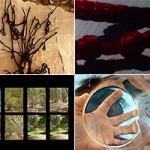DISPOSSESSED; (2013) Julia Jin; B/W and color 16mm; sound from HDV Vixia camcorder; 76mm and 26mm lens – TRT: 7.46
A journey reconciling the notions of the home and its paraphernalia as a private space through close textures and a subtle orchestra of sounds.
 What was your creative process with this film?
What was your creative process with this film?
I didn’t have too much of a plan when I started the actual process of making the film. I just played a lot with the Bolex before figuring that I very much wanted to play with the 76mm lens and colored 16mm — neither of which I had any experience with until this project. As I was filming I noticed that I was only filming very particular items, and they were paraphernalia from the times I went to China. From there it was just a hop, skip and a jump away from deciding that I wanted to use “home” as my main prompt.
After developing a great deal of test footage, I had the chance to step back and try to interpret my own past intentions and curate something from that. It was a constant process of questioning what the hell I was trying to do two weeks ago and picking out what spoke to me “now.” It’s something that still hasn’t changed. It’s been more than 6 months since I last watched this piece, and right now I’m trying to figure that out that all over again.
Was the shooting all “staged” or did you shoot and then compose it? Where was it shot?
Almost everything was shot in my apartment that I was living in at the time in Binghamton, New York, with a few shots that were taken in my family’s home back here in New York City. However, the sound was all from past family vacation footage when we went/returned to China.
Most of my shots were “staged,” but I can only say that after repeatedly experimenting with several, several test rolls. It was the first time I ever used a 76mm lens so I was physically struggling to prop it up while trying to beam enough light into the camera. Then, I curated the footage that had the most potential and re-shot them. Some of the supposed test footage did make it to the final cut — they are the shots that have been hand processed with all the scratches.
For the color footage, those were all more controlled, one-shot affairs since I’ve already had experience with 26mm lens, and was also much lighter/easier to wield.
 Tell us about the shift from B&W to color.
Tell us about the shift from B&W to color.
Throughout the entire film, I tried to play with contrast to accent certain characteristics of the sound or image. Some sequences have lively dialogues between sound and image, but some have more muted soundscapes with animated images. Some images are underexposed, and then are suddenly juxtaposed with images that are overexposed. Sometimes there’s a sequence with quick short shots, and then it’s followed by a shot that’s long and uninterrupted.
Similarly, the jump from B&W to color is a macro manifestation of all these contrasts that’s been happening throughout the film. The sound is liveliest right before the change, but it’s paired up with an already familiar texture. (I tried to construct it as very familiar, because right before that shot, a new, silky texture is introduced. After this novel image, I go back to the old image in order to mute the visuals and highlight the sound instead.) Following that, there is a brief interlude of low key sound and image, and then the flood of color and sound. So, there are a few points of contrast before and after the transition to color. The playful sounds of people and outdoor activity, and then the sounds of rain and thunder. The familiar muted textures, and then color — and with that, the ability to discern the objects.
While the first half is more texturally rich, with different exposures, film speeds, camera movements, abstractions, active sounds etc, the latter half is almost entirely only about color and seeing the objects. In a way, the latter half is like the falling action in a narrative. There is the initial shock of seeing color, and then the quick habituation of seeing a new space that is not really new (a professor once declared, upon seeing the image of the door, that “the door is really door-y”).
Why make this film?
The inception of this film was largely a product of my own perception of “school life.” When I declared my cinema major, I promised myself that I must make a Senior Thesis or Else, and was determined that this project would serve as a sort of finality to my college experience. It had to be the ultimate culmination of everything that I’ve learned and everything that I’ve become during this time period. Despite all the dressing and external narrative and hype I was building up for myself, I wound up approaching this project from a more simple space — my room. It wasn’t even the first time I filmed this setting. I have filmed my home space many times in the past, and in retrospect, almost exclusively that.
At the time, I wanted to approach the idea of “home,” and what it means to have all these different geographical spaces conglomerate together into…something. It was the first time I’ve ever consciously exercised with this idea, and named the project “dispossessed” as a way to push myself away from these familiar items and transform them into something new. I was looking at these things that were extremely consistent in my life with literally a new lens and a new type of film stock. It was also the first time I crafted a soundscape as well, from family vacation footage when we were in China. That was especially difficult because I never really used private family footage before, and had to get over the initial horrors of hearing my family’s voices in a public forum.
So, while the setting of the film has been used over and over again, this project is a bit different in that I tried harder to thrust my personal life at the camera. To me, the past films I made were too much like exercises. While the idea of experimental film itself is very adventurous, especially to a young undergrad with no experience in cinema, the structural films I made still felt too safe. They were too de-contextualized — too transformed from the original source — and there is something comforting when familiar images become too warped. When it reaches that point, it’s as if there wasn’t ever a dispossession to begin with. I wanted “dispossessed” to have a distance — to be novel and playful with its structure — but to also have very recognizable and plain objects as a reminder of its origins.




